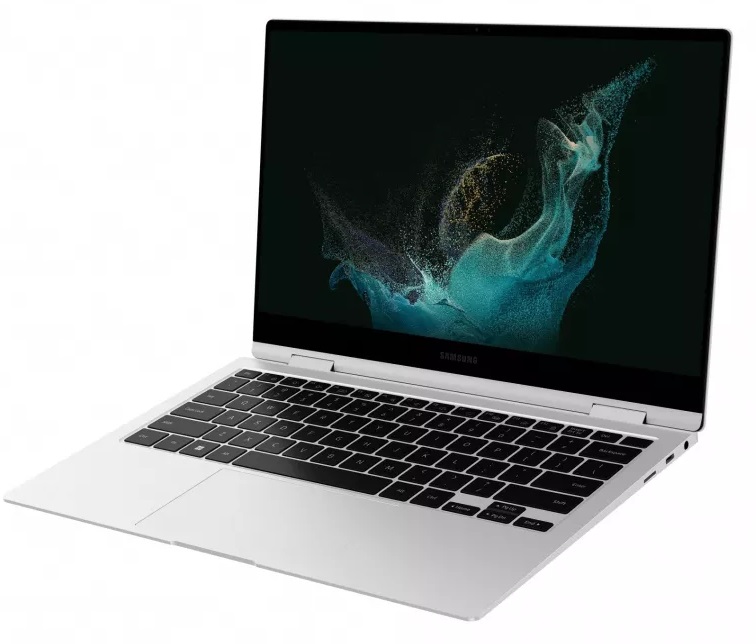Samsung Galaxy Book2 Pro 360 (2022) review: Minor improvements go a long way for this surprisingly powerful slim PC
The new Galaxy Book2 Pro 360 15-inch brings the power of 12th Gen Intel to this ultra-thin laptop.
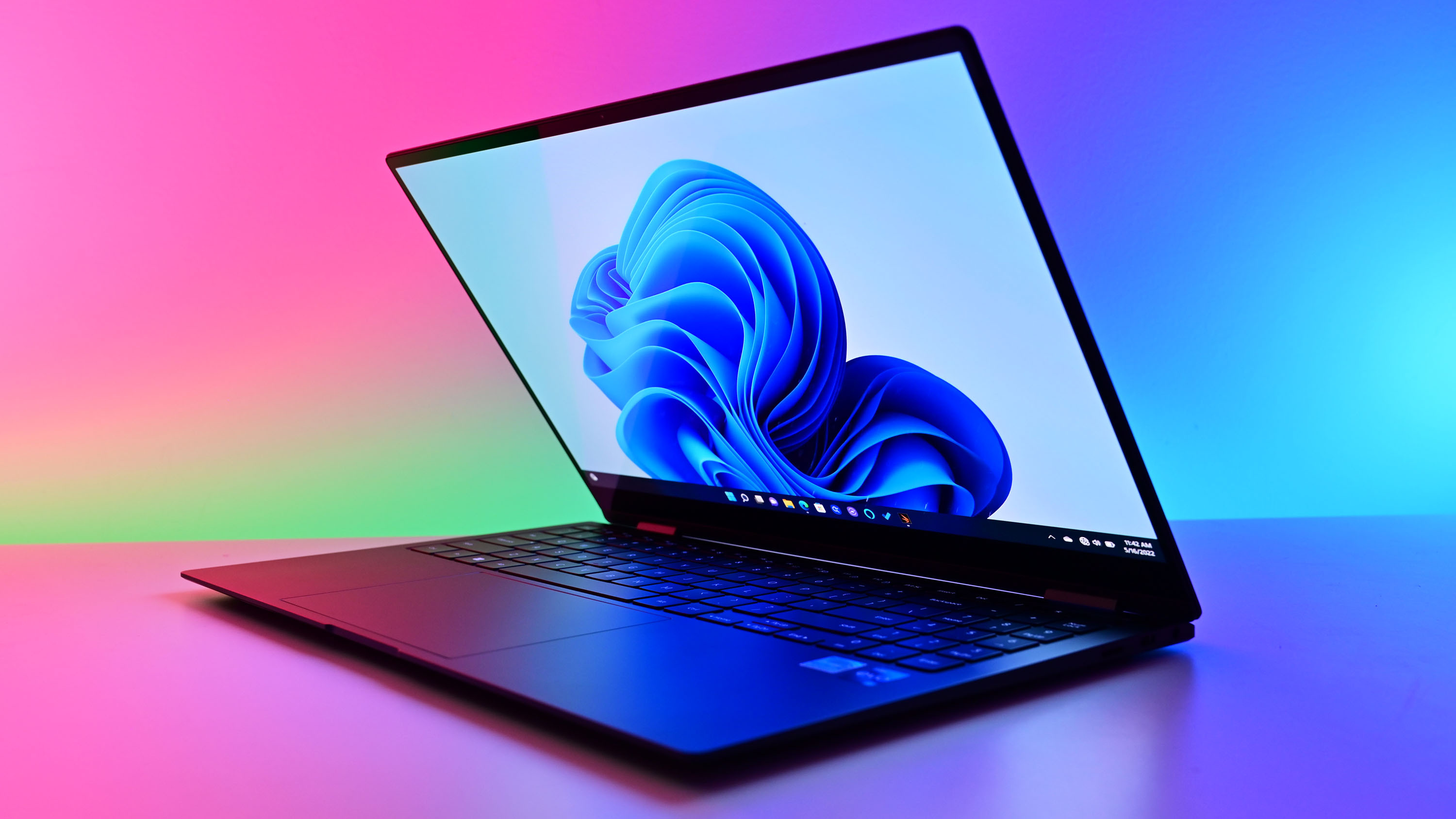

Samsung is no stranger to Windows laptops, although it does have a tough time sticking with one product line or naming scheme. I first fell for its unusually light designs back in 2017, when I bought and reviewed the Samsung Notebook 9 15 Ext, and since then, the company has consistently created fun and unique ultra-mobile PCs.
Announced in March, Samsung has now refreshed its 2021 lineup of super-thin Galaxy Book Pro laptops, which are now called Galaxy Book2 Pro.
The big advances for 2022 come from the hardware's multi-media and video conferencing improvements, much of which is required or recommended for the 3rd Gen of Intel's Evo specification. For instance, the webcams go from 720P to 1080P full HD with a wider 87° wide-angle lens. Those cameras can do auto-framing, blur your background, and more "smart" features necessary for today's video-conferencing-focused work environment. There is also now bi-directional AI noise-canceling for the microphones and speakers.
This review focuses on the $1350 Galaxy Book2 Pro 360 15, which is now available to purchase. That price is slightly lower by $150 compared to the 2021 model.
With its gorgeous AMOLED display, excellent S Pen, and a surprisingly robust software suite, Samsung is playing for keeps. But the company also has some oversights that place it just out of reach of greatness. Luckily, its great pricing helps redeem it in the end.
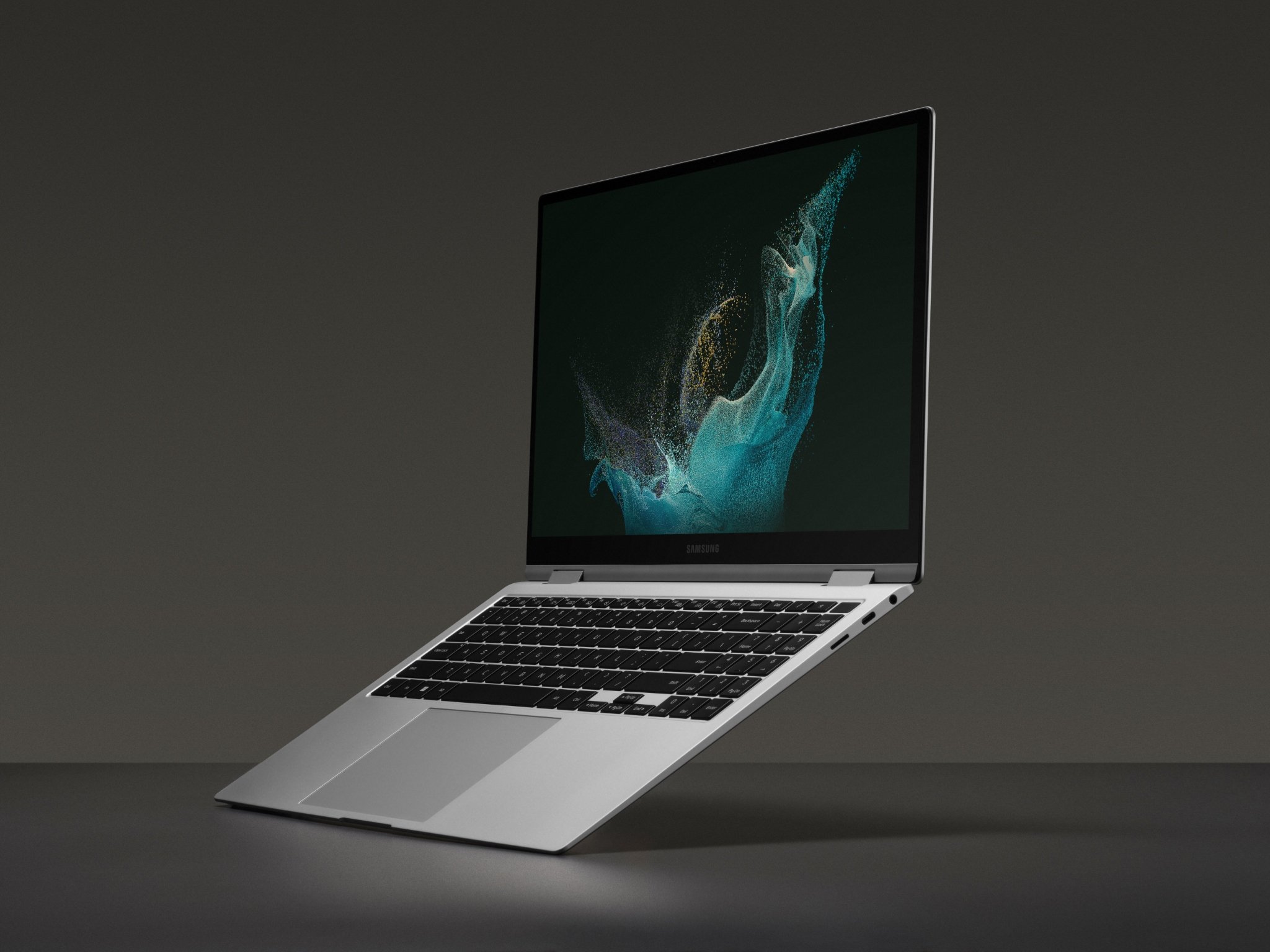
Bottom line: The Samsung Galaxy Book2 Pro 360 is one of the only thin-and-light 15-inch convertible PCs on the market that also has an excellent AMOLED display and inking experience. It's sharp-looking, fun to use, and has performance when needed. Samsung is within reach of a perfect laptop design but falls just short.
For
- Outstanding AMOLED display
- Excellent inking and convertible experience
- Thin and light with excellent performance
- Decent battery life
- Improved webcam
Against
- Mediocre speakers
- 16:10 would have been a better display aspect
- Lots of fingerprints on chassis
- Only full HD screen resolution
Samsung Galaxy Book2 Pro 360: Price, availability, and specs
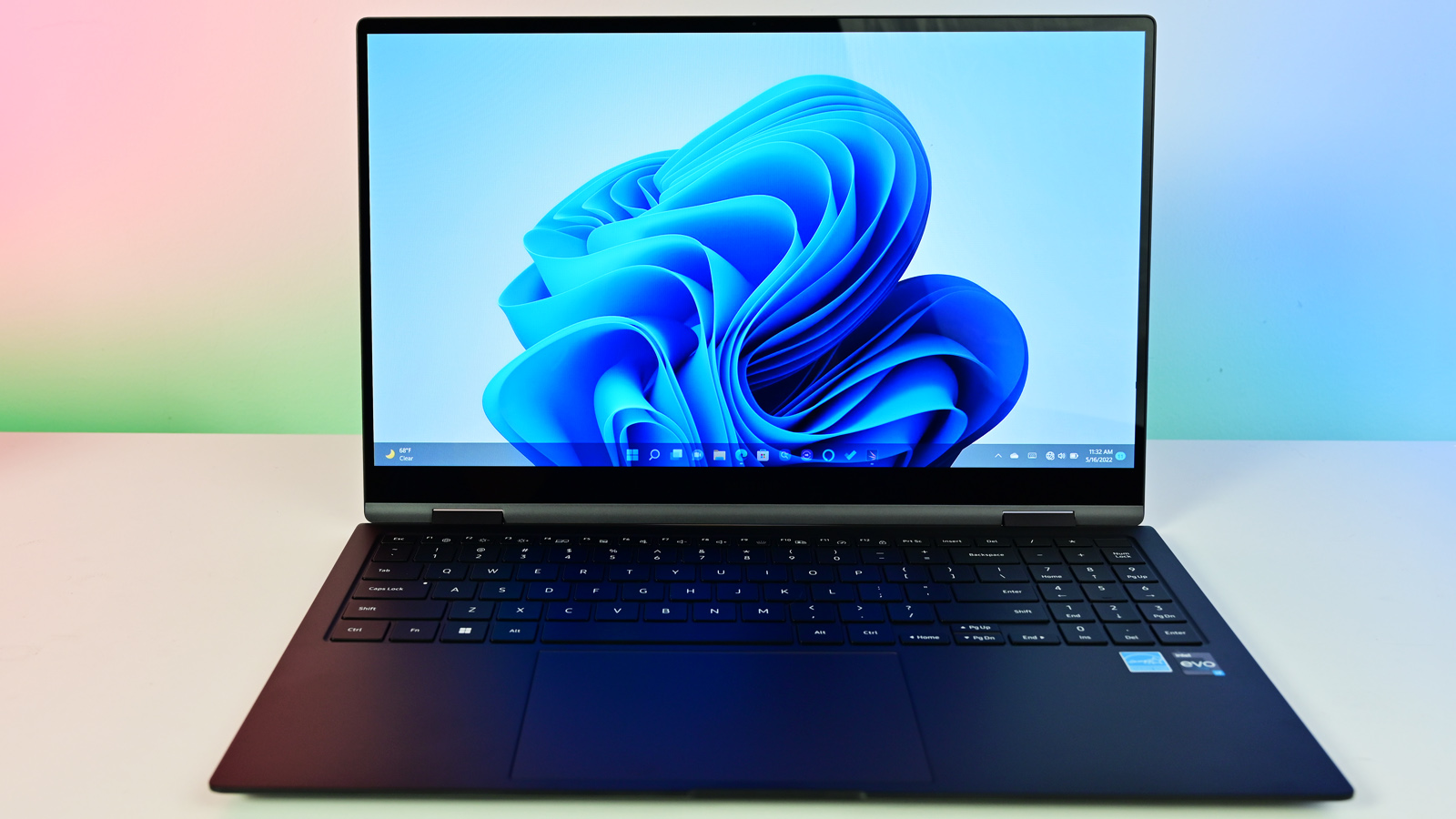
The Samsung Galaxy Book2 Pro 360 (and the non-360 model) is now available from Samsung.com and Best Buy.
You can choose between 13.3-inch and 15.6-inch models in either the "360" chassis (convertible) or a traditional laptop design. This year, they're only doing a Core i7 for the CPU. There is also a 5G option, but it is limited to the Galaxy Book2 Pro (15.6) non-360 model and is not expected to ship until later this summer.
Get the Windows Central Newsletter
All the latest news, reviews, and guides for Windows and Xbox diehards.
Pricing starts at $849 for the 13.3-inch Galaxy Book2 Pro 360 and $1,049 for the Galaxy Book Pro 360. The 15.6-inch model reviewed here in graphite ships with a Core i7 CPU, 16GB of RAM, Windows 11 Home, and 1TB SSD for $1,550 ($50 more than last year's model).
Samsung also says a version with Intel's new Arc GPU should be offered soon, although we have not seen it listed just yet as an option. Arc should offer 2x the graphics performance of Iris Xe, although we have yet to test it ourselves.
Samsung allows trade-ins of phones, PCs, or tablets, which can offset a Galaxy Book2 Pro/Pro 360 purchase up to $550 (although only the Samsung Tab S7+ qualifies for that price point, with most devices falling well below that).
| Category | Galaxy Book2 Pro 360 (13.3) | Galaxy Book2 Pro 360 (15.6) |
|---|---|---|
| OS | Windows 11 Home | Windows 11 Home |
| Processor | 12th Gen Intel Core i7 (Evo) | 12th Gen Intel Core i7 (Evo) |
| RAM | 8GB, 16GB, 32GBLPDDR5 | 8GB, 16GB, 32GBLPDDR5 |
| Graphics | Intel Iris Xe | Intel Iris Xe |
| Storage | 256GB, 512GB, 1TBM.2 PCIe NVMe SSD | 256GB, 512GB, 1TBM.2 PCIe NVMe SSD |
| Display | 13.3 inches1920x1080 (FHD)16:9 aspect ratioTouchSuper AMOLED | 15.6 inches1920x1080 (FHD)16:9 aspect ratioTouchSuper AMOLED |
| Inking | S PenIncluded | S PenIncluded |
| Ports | Thunderbolt 4Two USB-C3.5mm combomicroSD card reader | Thunderbolt 4Two USB-C3.5mm combomicroSD card reader |
| Audio | Dual 4W speakersSmart AMPDolby AtmosSound by AKG | Dual 5W speakersSmart AMPDolby AtmosSound by AKG |
| Connectivity | Wi-Fi 6E, Bluetooth 5.1 | Wi-Fi 6E, Bluetooth 5.1 |
| Camera | Front-facing 1080pDual array mic | Front-facing 1080pDual array mic |
| Keyboard | BacklitIsland type | Backlit3-row numericIsland type |
| Security | Fingerprint reader | Fingerprint reader |
| Battery | 63Wh65W AC adapter | 68Wh65W AC adapter |
| Dimensions | 11.9 x 7.9 x 0.45 inches(302.5mm x 202mm x 11.5mm) | 13.97 x 8.98 x 0.47 inches(354.85mm x 227.97mm x 11.9mm) |
| Weight | 2.29 pounds (1.04kg) | 3.1 pounds (1.41kg) |
| Color | SilverGraphiteBurgundy | SilverGraphiteBurgundy |
Samsung Galaxy Book2 Pro 360: Design and features
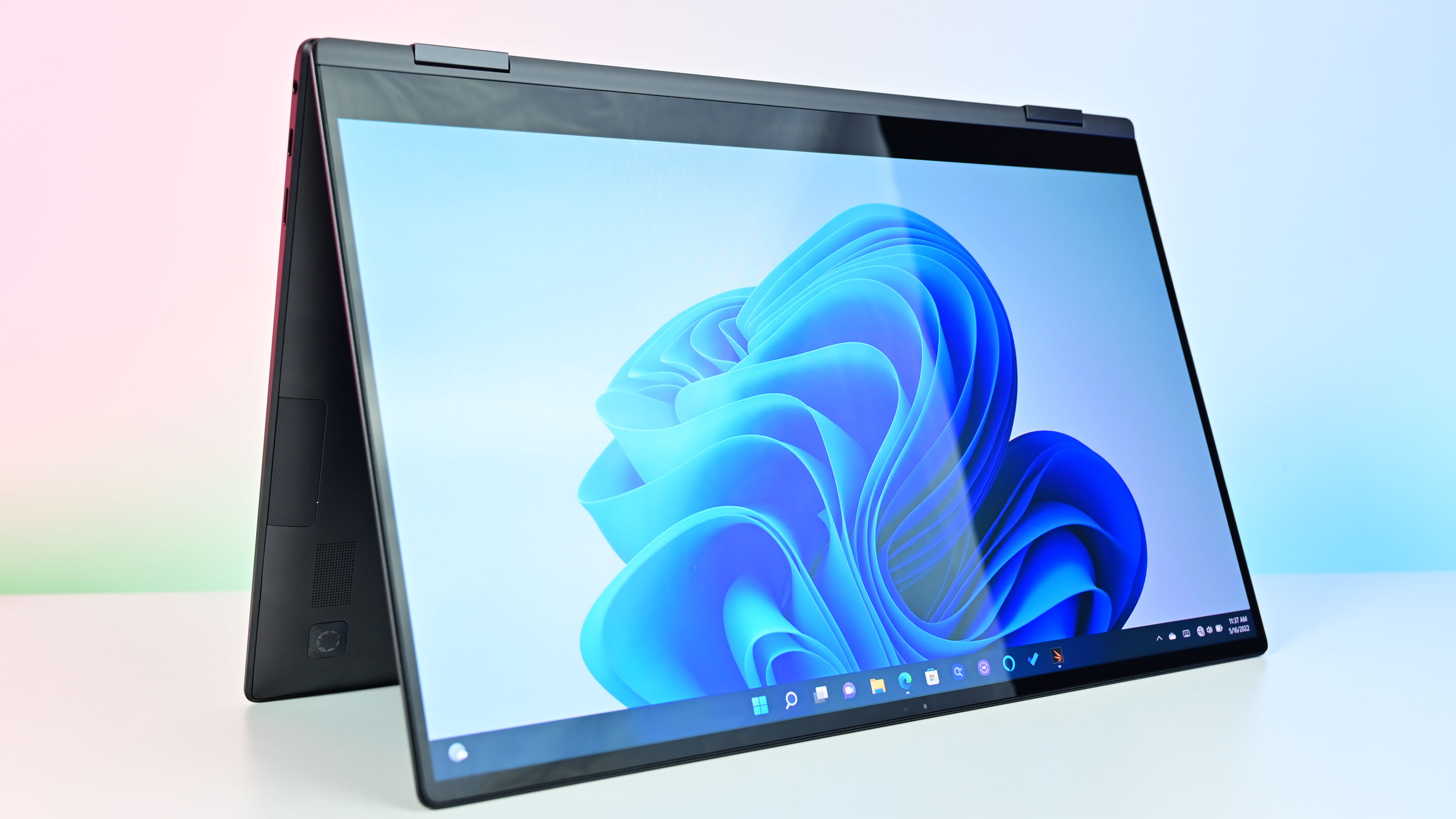
The Galaxy Book2 Pro 360 15 is an Intel-based convertible Ultrabook that includes a Samsung S Pen for inking and drawing. It features the more powerful Intel Core i7-1260P processor (instead of a less powerful U-series) and packs 12 cores, and 16 threads, with a base power of 28 watts.
This laptop is Intel Evo certified, which means it has been specially tuned for instant-on, fast resume, Wi-Fi 6E, and longer than average battery life.
While the smaller 13.3-inch version has a lot of competition, the larger 15.6-inch model reviewed here is a rarity, as most laptops this size add in a discrete NVIDIA GPU, which this laptop does not have. Instead, this is a slim, lightweight Ultrabook that can also be used with a pen. That difference means the Galaxy Book2 Pro 360 15 is excellent for productivity but not ideal for serious gaming or video editing (though it can, of course, handle lighter loads in those categories).
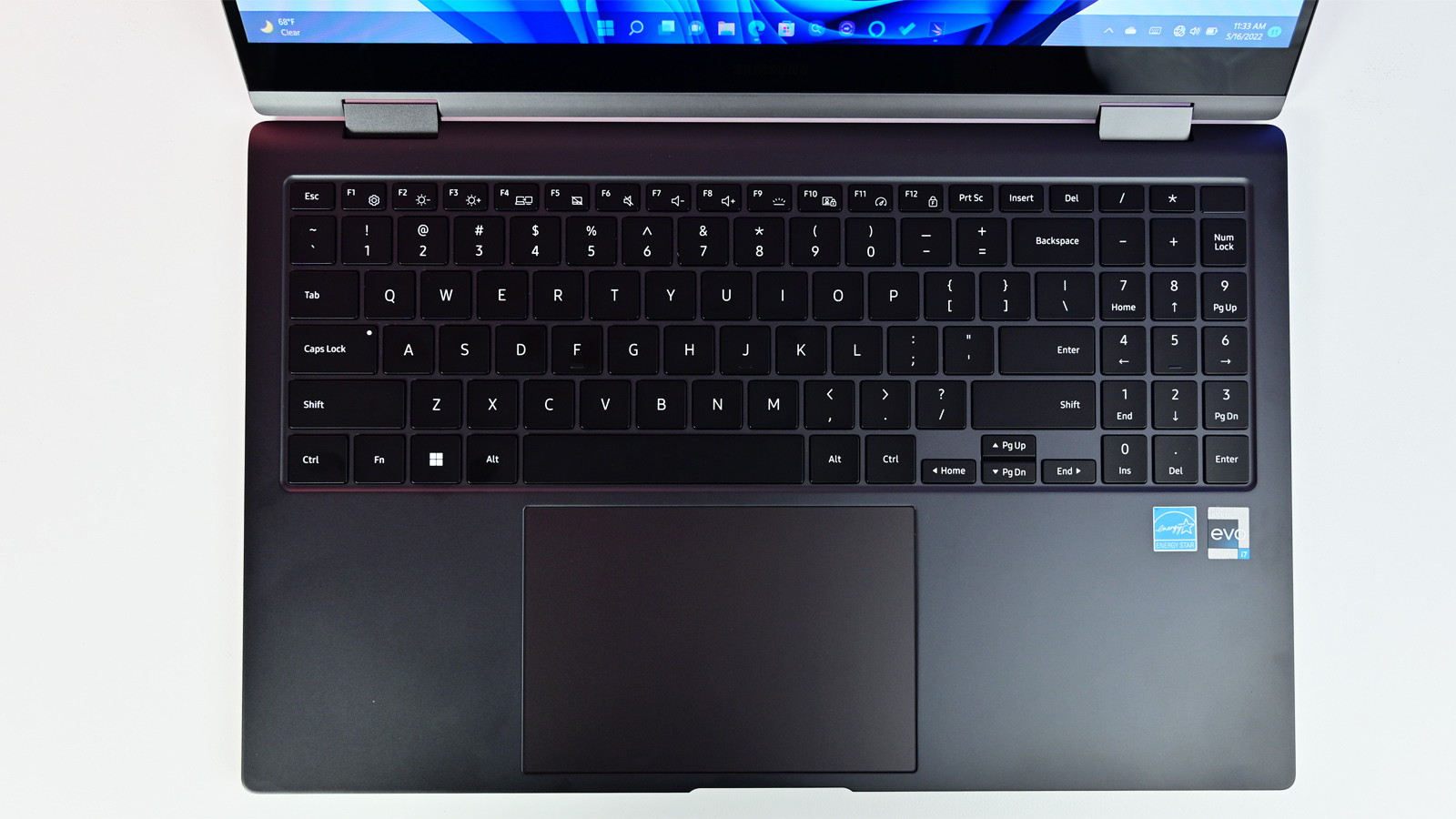
Design-wise, this is a very Samsung laptop. The color options – silver, graphite (instead of mystic blue), and now burgundy – match its Galaxy phones and borrow a lot from its mobile phone division, which is a good thing.
While graphite looks nice, it is very prone to hand oils, and fingerprints require frequent wipe-downs to keep it looking as good as it does in these photos. If this is a concern, the lighter silver is a better choice. (Personally, I find the Galaxy Book Flex's color and design more satisfying, and I wish Samsung would just update that model.)
At just 3.1 pounds (1.41kg) and an incredible 11.9mm thin, the Galaxy Book2 Pro 360 is extraordinarily light and portable, considering the 15.6-inch touch display.
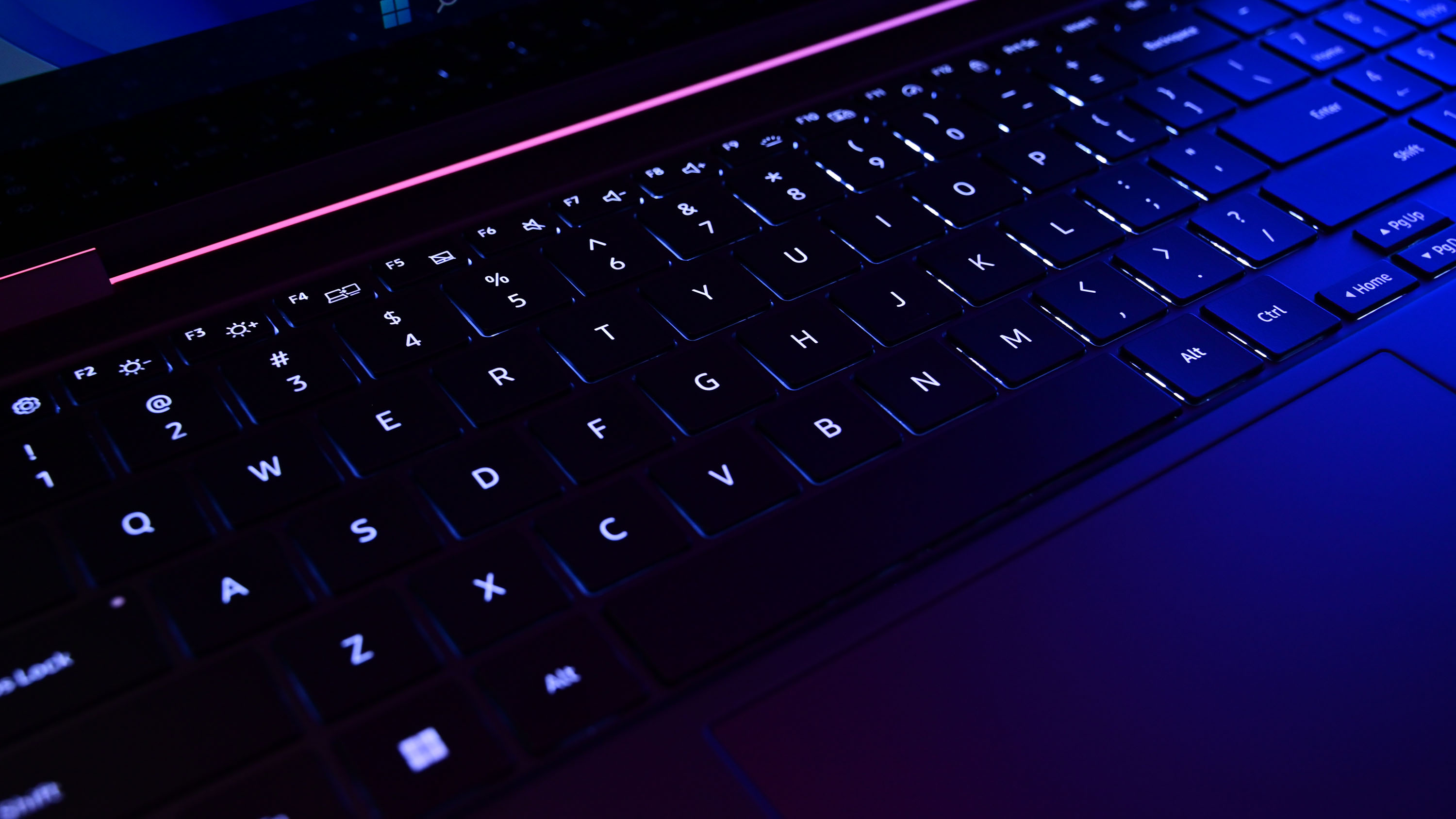
Ports are limited to just three USB Type-C with one (on the left) reserved for the higher-performing Thunderbolt 4. There is, however, a MicroSD slot for multi-media and a combo microphone/headphone jack. While a Type-A port would have been nice, the laptop is too thin to house one.
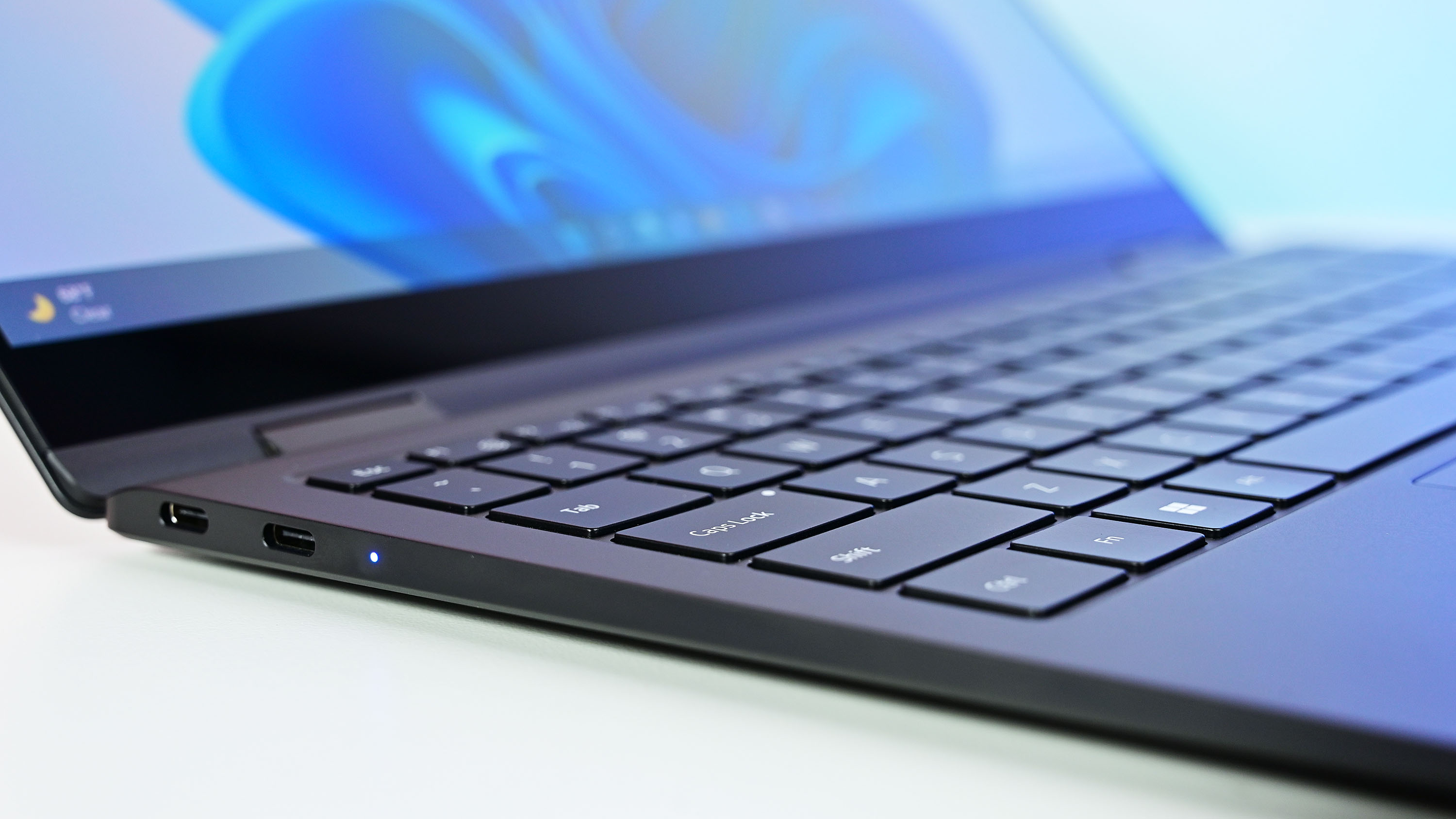
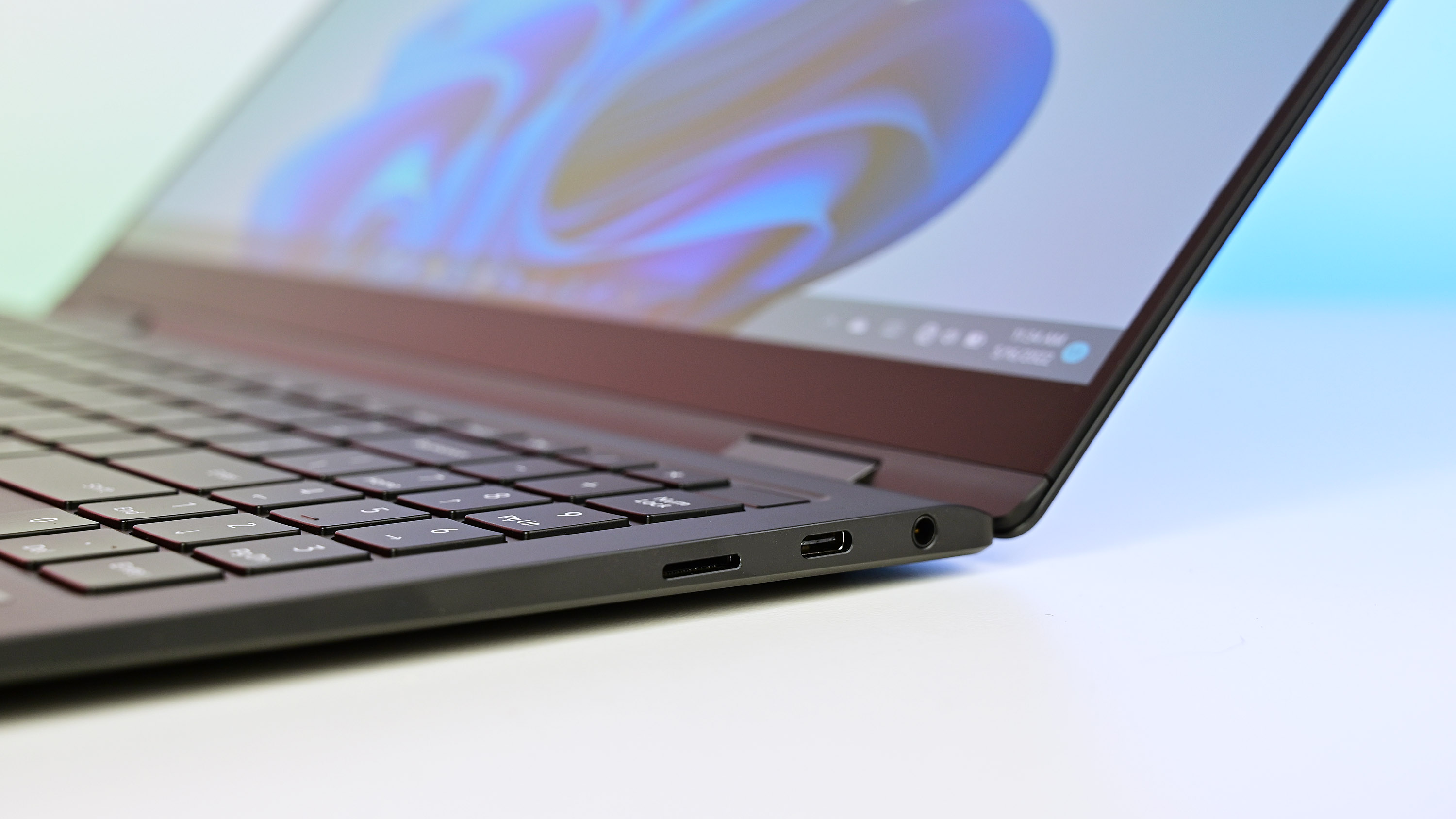
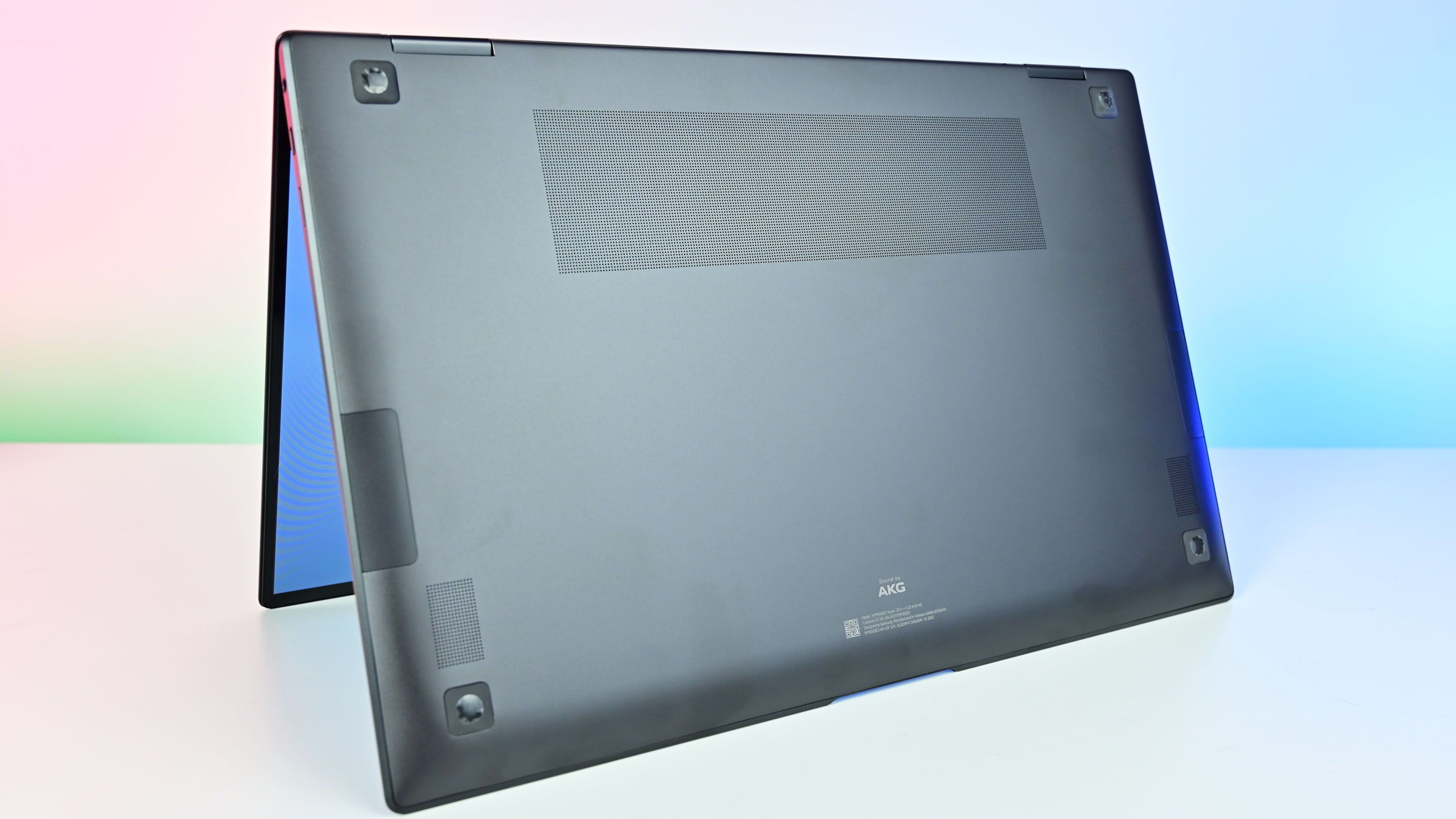
Two AKG speakers with Dolby Atomos software are on the bottom edge of the laptop. They are good speakers, but their placement does not sound as good as top-firing designs and lacks resonance and bass. Companies like HP rightly put four speakers into their "360" laptops and pre-amp them, so the sound is as good in tablet mode as in a standard laptop. However, likely due to space concerns, Samsung faced severe limits in making this laptop so thin.
The keyboard is on the shallower side with only 1mm of travel (1.3mm is ideal). But thanks to the scissor mechanism and rubber dome design, it feels pretty good once you use it for a little while. Samsung includes three-stage backlighting, which is done exceptionally well with slight light bleed (it also has a nice fade effect). It is worth noting that number pad lovers will be happy with the keyboard design in the 15-inch too.
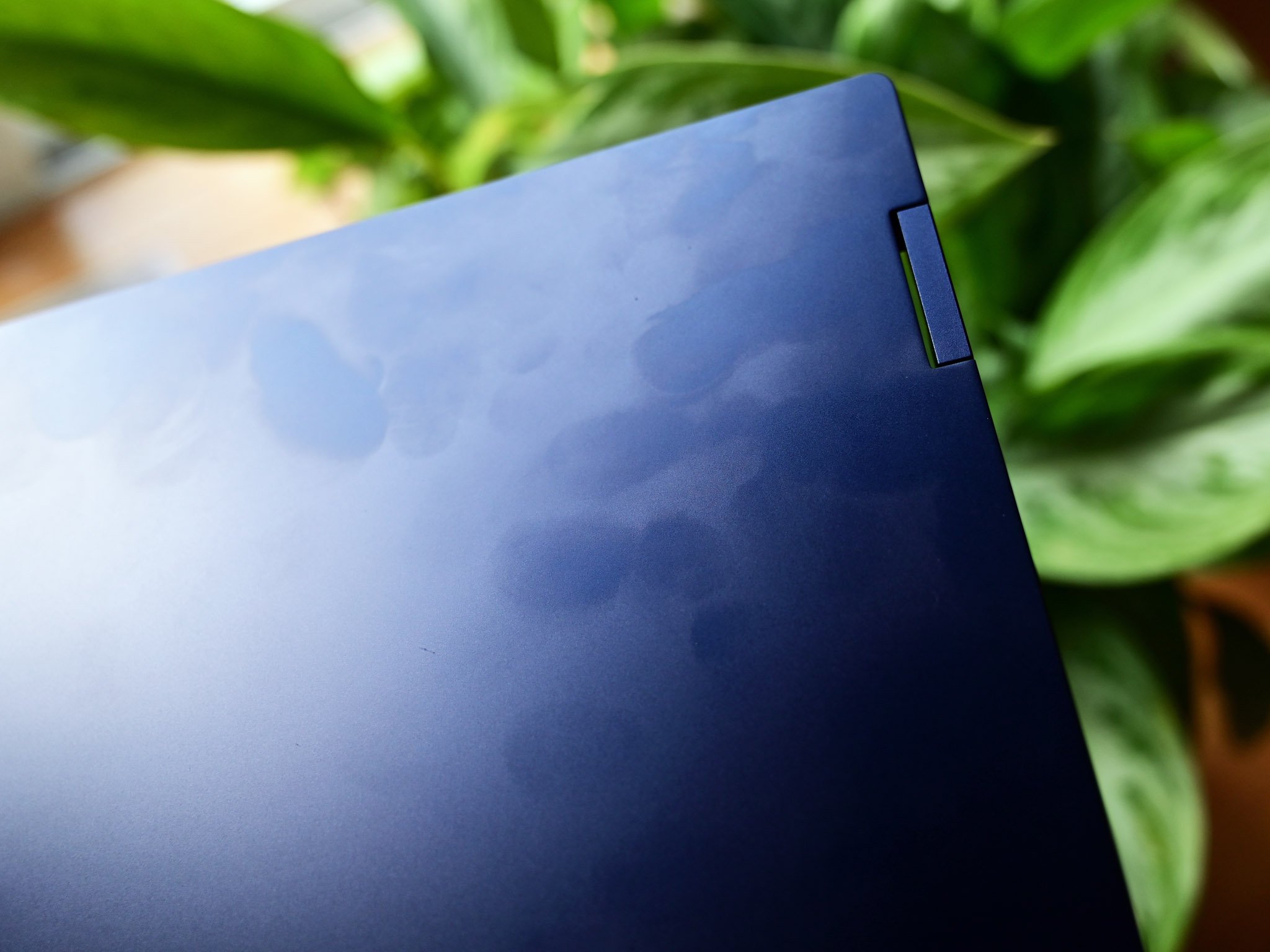
The trackpad is huge compared to other laptops in this class. It uses Microsoft Precision drivers and has a satisfying click with exceptional smoothness.
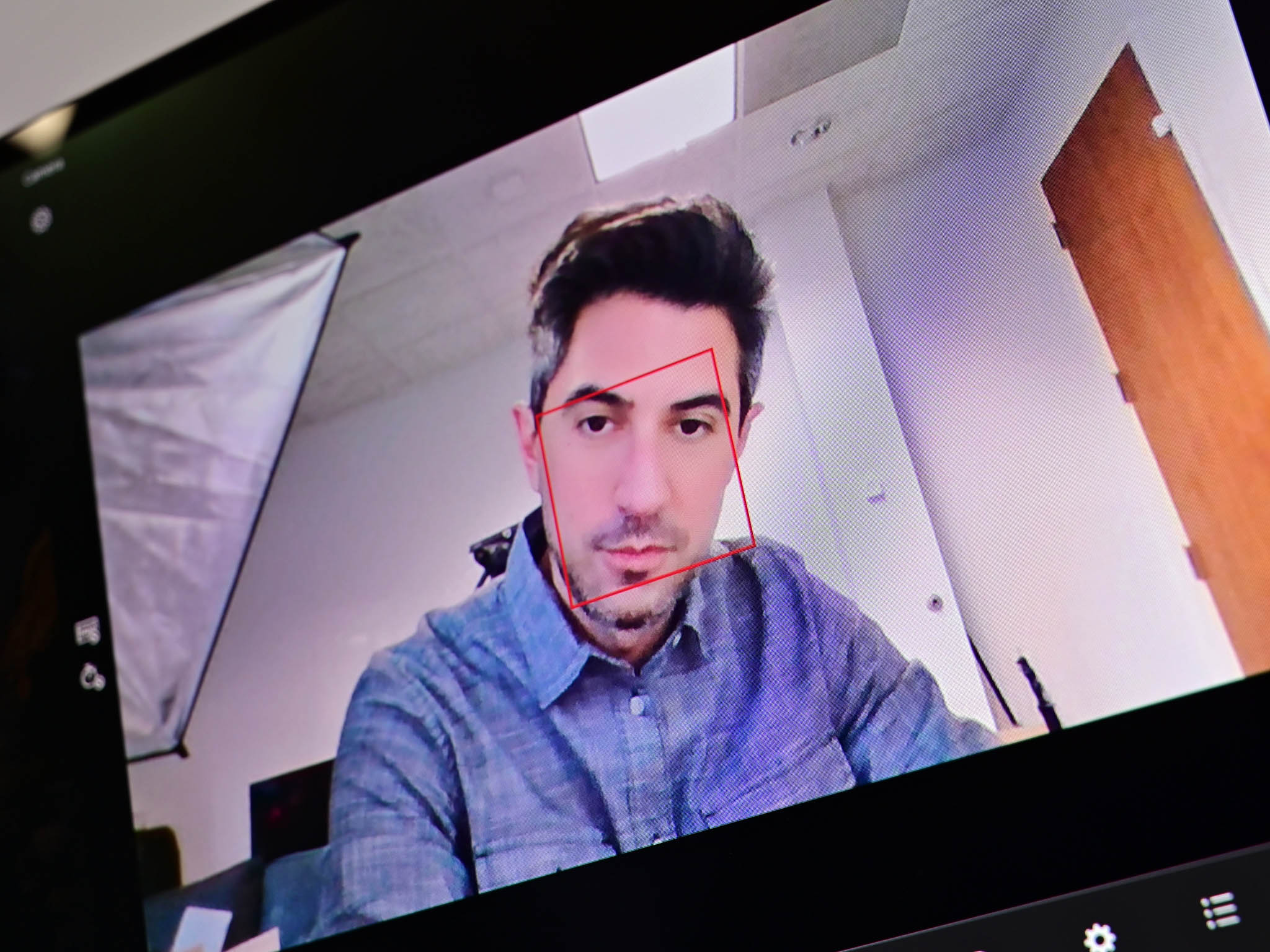
The front-facing 1080P camera is a big step up from last year's poor 720P version. It's sharper and the color looks good. It's not the best webcam on the market, but it's on the better side.
There is also no face recognition to log into Windows 11, but Samsung offers a fingerprint reader on the top deck instead. It's a decent reader, found in the power button for convenience, but accuracy is only mediocre requiring multiple reads on occasion.
The all-metal chassis does have some flex to it, but it is nothing outrageous. Considering the thin design and goals of this laptop, it is acceptable. The bottom has a relatively large intake to cool the processor, and the exhaust is expelled via the rear hinge area, giving a clean design. Indeed, the entire laptop can be described as elegant and professional looking with minimal and almost hidden Samsung branding.
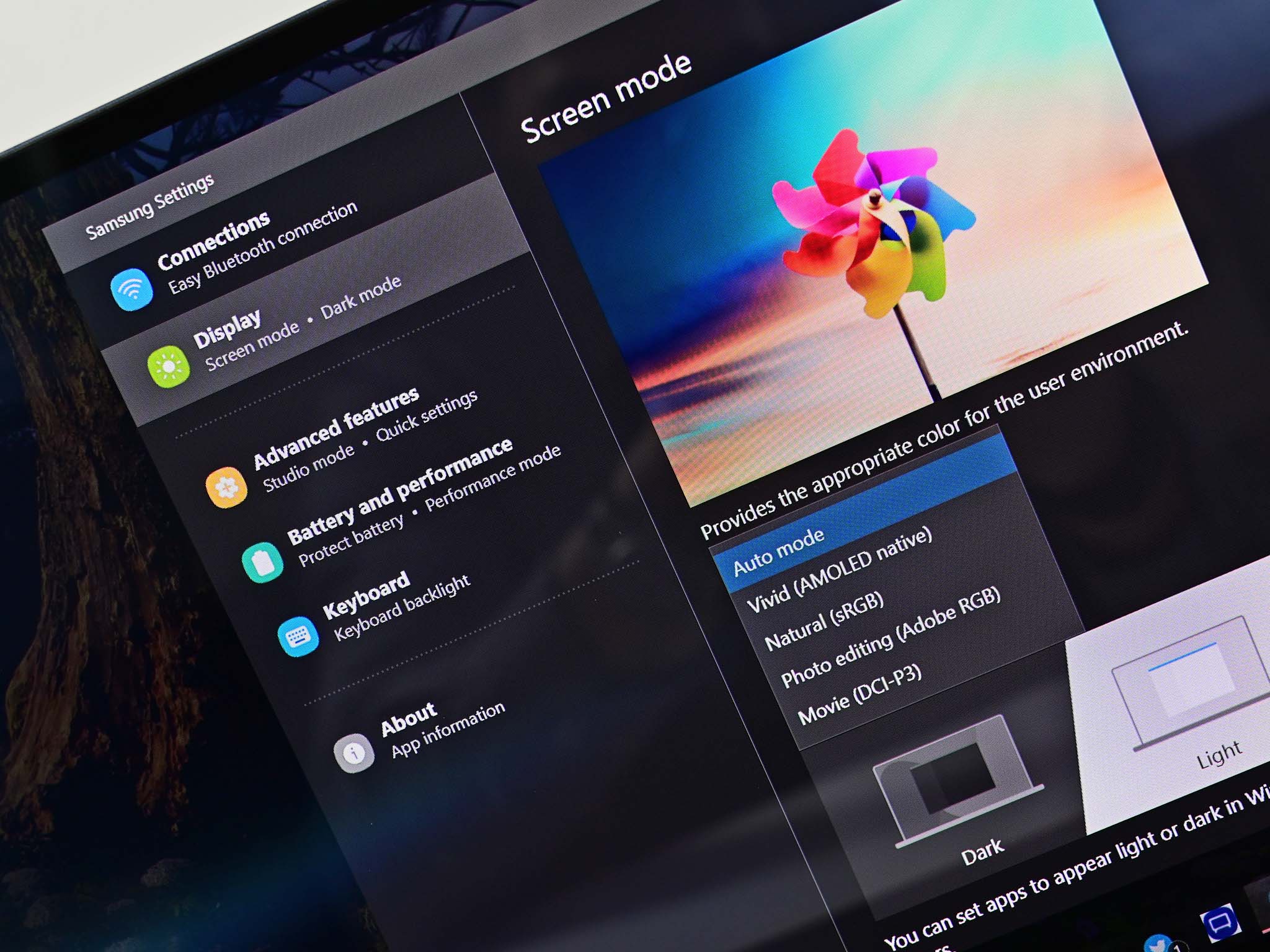
Samsung includes an insane 28 of its own apps, services, and software tweaks in the Galaxy Book2 Pro 360. The instinct is to call this "bloatware," but that would be a disservice. Samsung's software, which is often a 1:1 clone of what is found on its popular Galaxy phones, is a selling point for this laptop, not a negative. The apps include:
- Air Command
- Clip Studio
- Connect
- Galaxy Book Experience
- Galaxy Book Smart Switch
- Link Sharing
- Live Message
- Live Wallpaper
- Online Support (S Service)
- PENUP
- Quick Search
- Quick Share
- Samsung Bluetooth Sync
- Samsung Care+
- Samsung DeX
- Samsung Flow
- Samsung Gallery
- Samsung Notes
- Samsung PC Cleaner
- Samsung Recovery
- Samsung Security
- Samsung Settings
- Samsung Studio Plus
- Samsung TV Plus
- Samsung Update
- Samsung Voice Note
- Samsung Screen Recorder
- SmartThings
It's … a lot. But things like Samsung Security let you digitally lock the microphone and camera so the software cannot be used to spy on you. It can even email you a pic of someone trying to hack your laptop (for real). PENUP is a coloring app for adults, which lets you use the included S Pen in a fun and relaxing way. Apps like Gallery, Notes, TV Plus, Live Message, and Air Command are mirror images of Samsung's Galaxy phone apps and often sync to them via your Samsung account. Live Wallpaper lets you choose premade wallpapers that slightly change based on current weather and whether it is day or night. It is all clever stuff that enhances the laptop experience. Of course, it can all be uninstalled, too, should you find it offensive.
Samsung Galaxy Book2 Pro 360: Display and inking
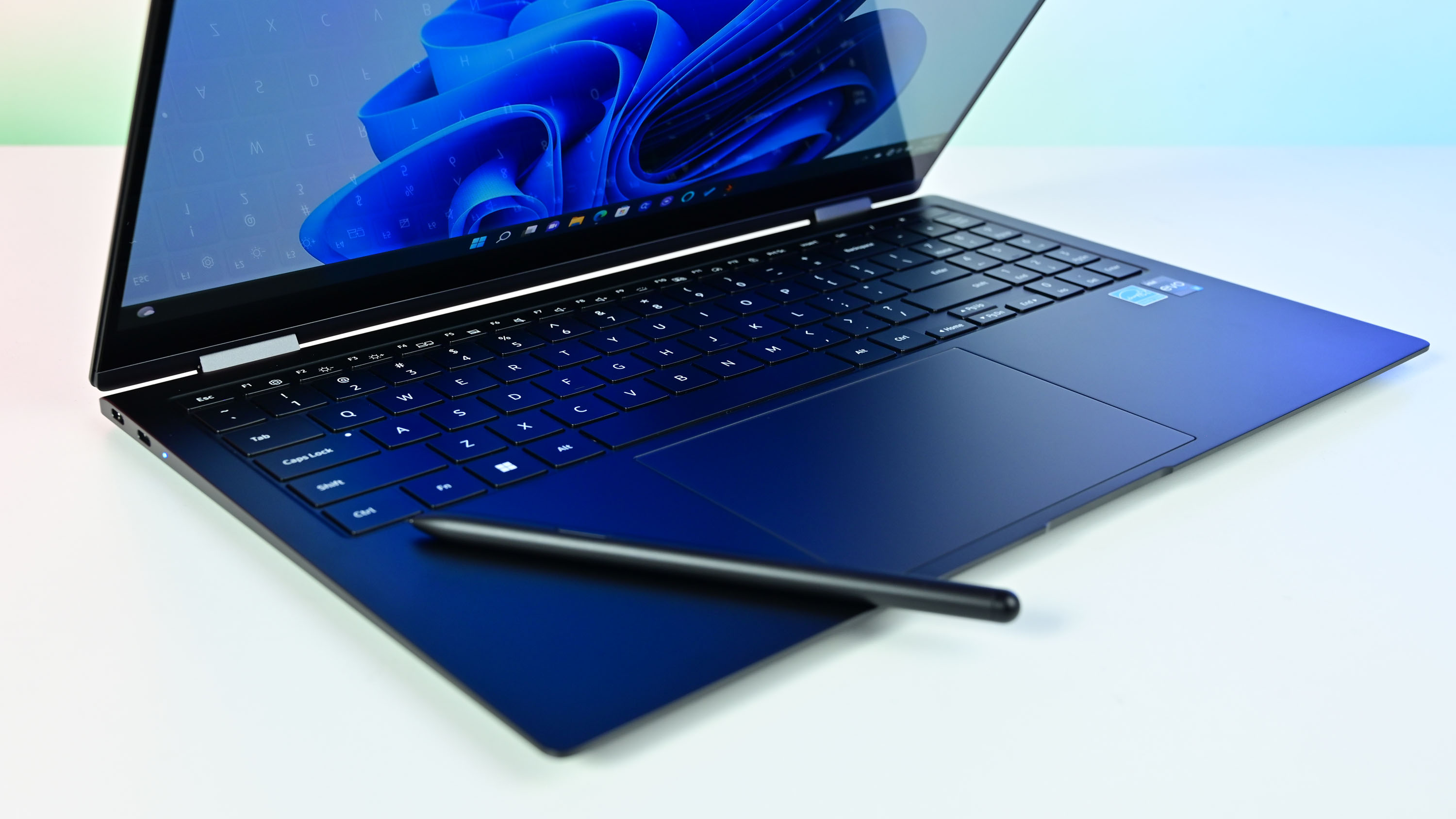
If there is one big selling point of the Galaxy Book2 Pro 360, it is Samsung's famed AMOLED display technology. While AMOLED is common in TVs and now smartphones, it is unusual in laptops. Samsung has experimented in the past with Super AMOLED (sAMOLED) in its 2018 Galaxy Book2, and QLED in Galaxy Book Flex, but used standard TFT in its recent Galaxy Book S.
AMOLED lives up to the hype. In our tests, the Galaxy Book2 Pro 360 delivers exceptional color representation with 100% sRGB, 85% AdobeRGB, and 96% DCI-P3 – all of which are way above average for this laptop class.
Samsung also brings some clever tricks, too. For instance, like high-end HP laptops, the display can auto-switch color profiles based on the application ("Intelligent Color Engine"). So, Adobe RGB is used for photo editing, whereas when watching a movie, it'll go to DCI-P3 and use vivid for everything else. Also, like HP, there is a "focus mode" that auto-dims the background to help extend battery life.
The Galaxy Book2 Pro 360's display is striking and slightly disappointing at full HD and 16:9.
VESA DisplayHDR 500 is also supported, which makes movie watching a blast with a higher contrast range. The screen also supports wide-color gamut (WCG) natively in Windows, including apps that support it. With "adaptive color," the laptop auto-adjusts the color based on lighting (this is different from auto-brightness, which is also an option).
Last year's model wasn't very bright coming in under 300 nits of brightness (although it still looked OK due to being AMOLED). Thankfully, Samsung improved things with the Galaxy Book Pro2 360 as it is now closer to 500 nits, which is 33% brighter than the model from 2021.
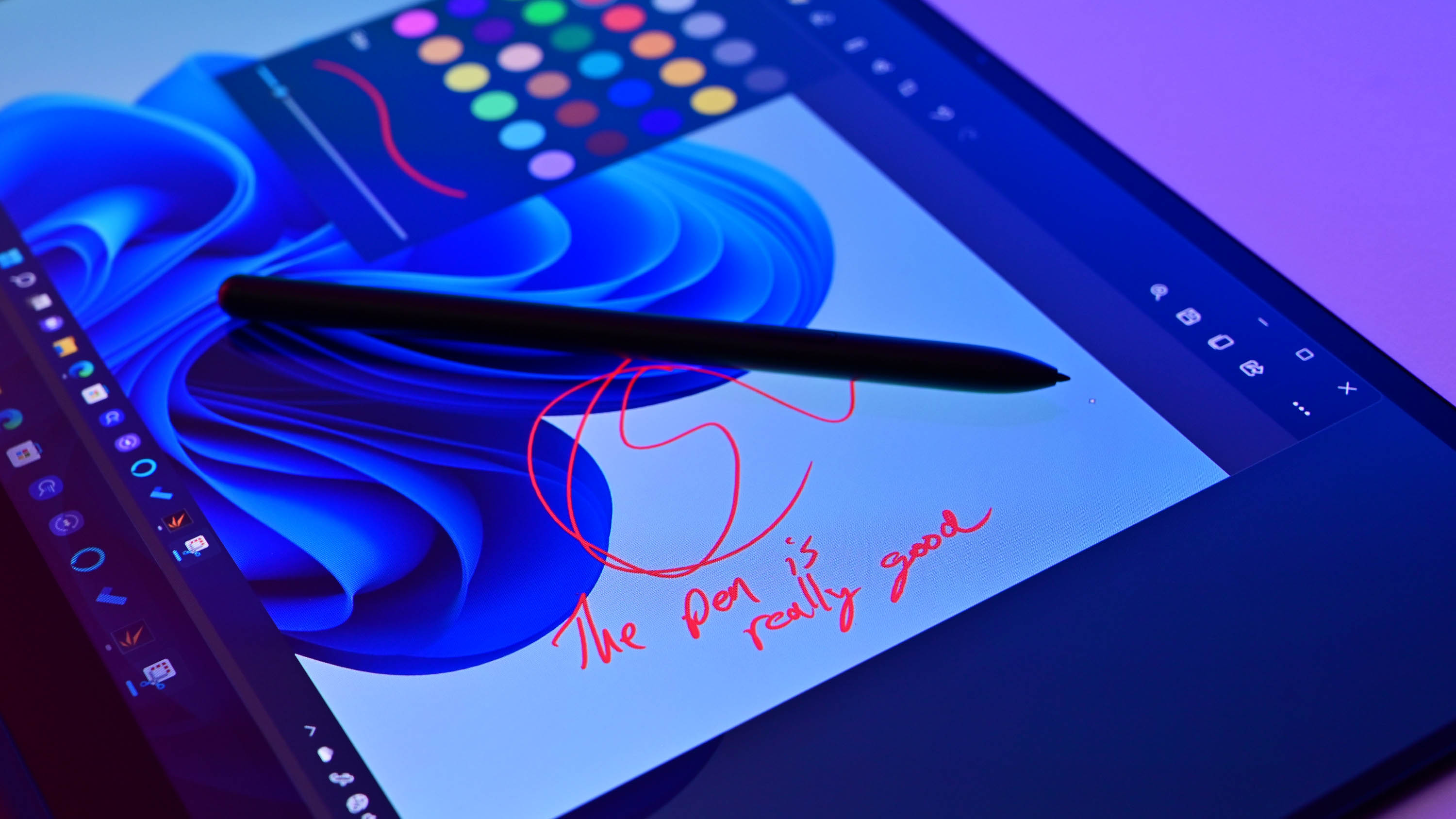
Another area of concern is the full HD 1920 x 1080 resolution. While such a resolution is OK on a 13.3-inch screen, it pushes the limits on a 15.6-inch one where the AMOLED pixels become visible and text is more jagged than preferred. It is not bad, but a "2K" resolution at 1440p would have been an excellent middle ground. As a plus, the full HD does help increase graphics performance and extend battery life.
Like Samsung's TVs, the Galaxy Book2 Pro 360 has a glossy screen, but due to the design, it reflects much darker than an LCD, giving pleasing results and much lower reflectivity than similar laptops.
The included S Pen is outstanding. Although Samsung's pen technology in laptops is not as widely used as Wacom AES or N-trig (Surface), I'd argue that it's the best feeling for latency and accuracy as a casual user. The S Pen doesn't even need batteries or charging. The downside is because the S Pen is now 2.5x thicker, which is excellent for ergonomics, there is no place to silo it like with the Galaxy Book Flex. Instead, it can stick to the lid with some magnets, but it being black makes it extremely easy to lose in a bag.
Samsung's S Pen technology is also interchangeable with its smartphones and tablets, which is nice if you buy into Samsung's entire ecosystem.
Samsung Galaxy Book2 Pro 360: Performance and battery
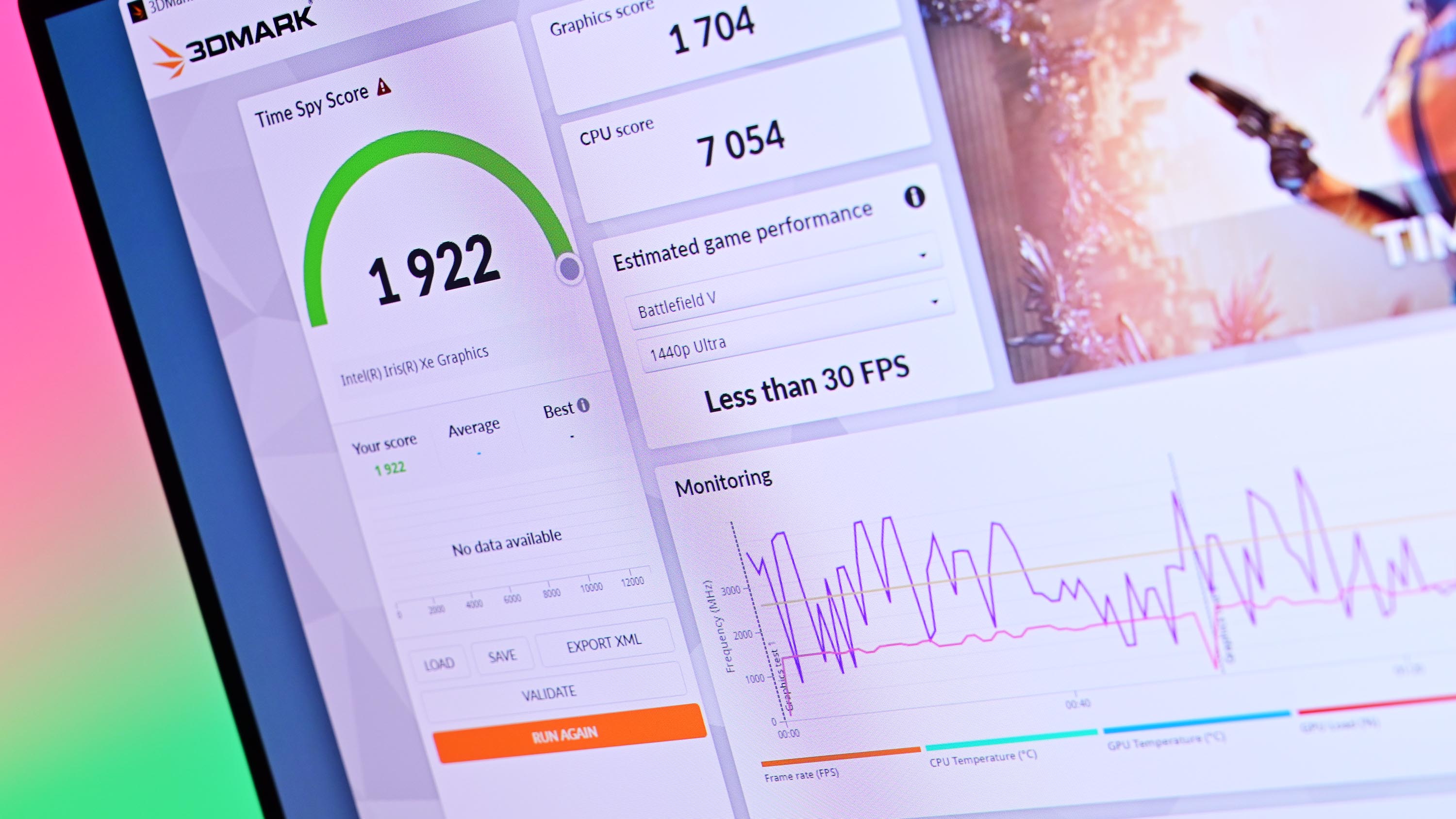
Intel 12th Gen P-series processors are a massive improvement over 11th Gen due to the big.LITTLE architecture, which jumps to 12 cores from 4 and increases CPU speed.
Interestingly, Samsung could have opted for the more battery-efficient U-series of chips and still beat last year's model. But by going with P-series, the performance of the Galaxy Book2 Pro 360 is closer to that of a 45-watt 11th Gen H-series chip, which is incredible.
Samsung worked closely with Intel to maximize the Core i7-1260P, and it can achieve some great results. With a key combo (FN + F11), you can toggle between No Fan, Silent, Optimized, and High Performance modes. These modes are independent of the Windows 11 battery slider found on regular laptops.
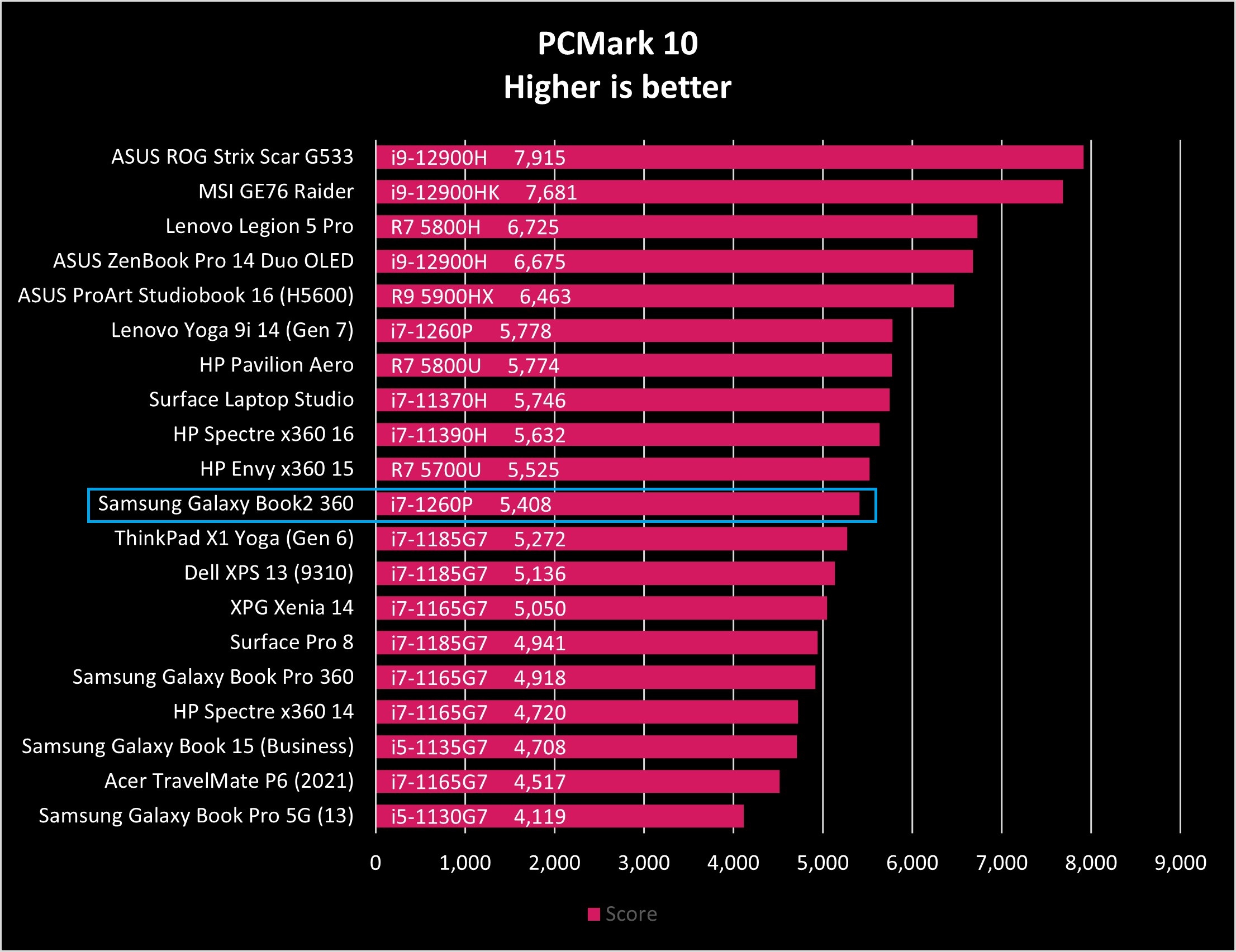
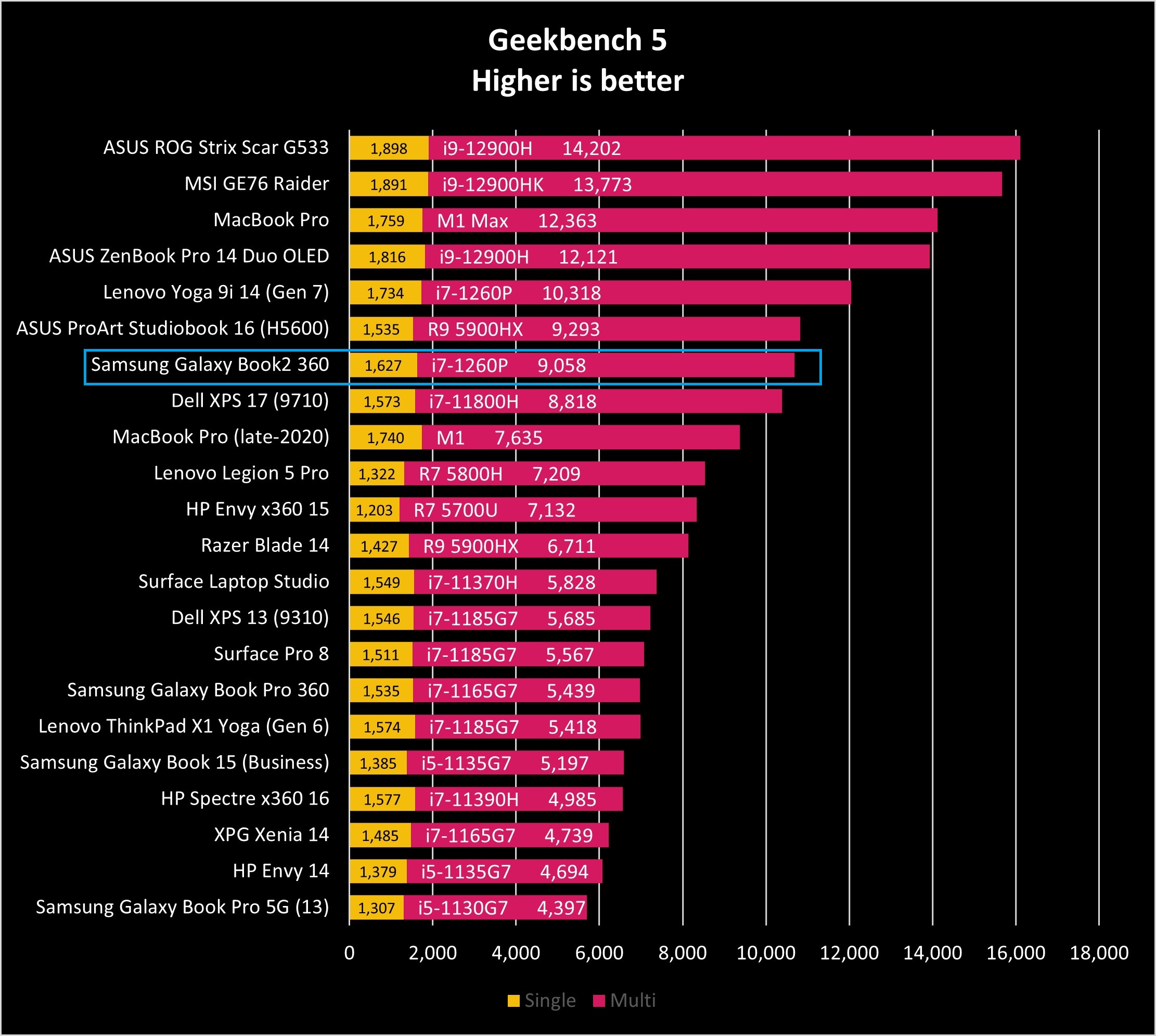
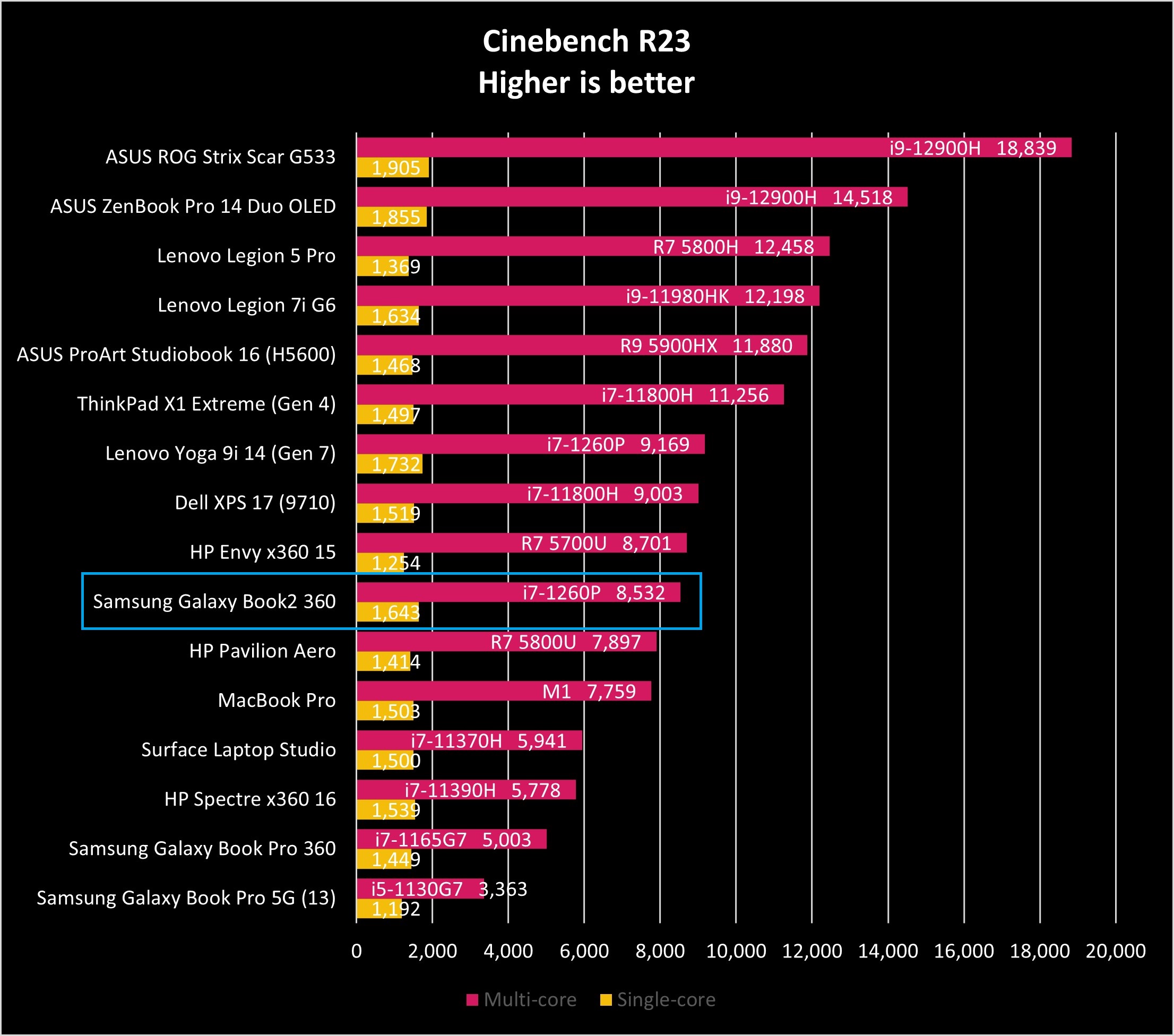
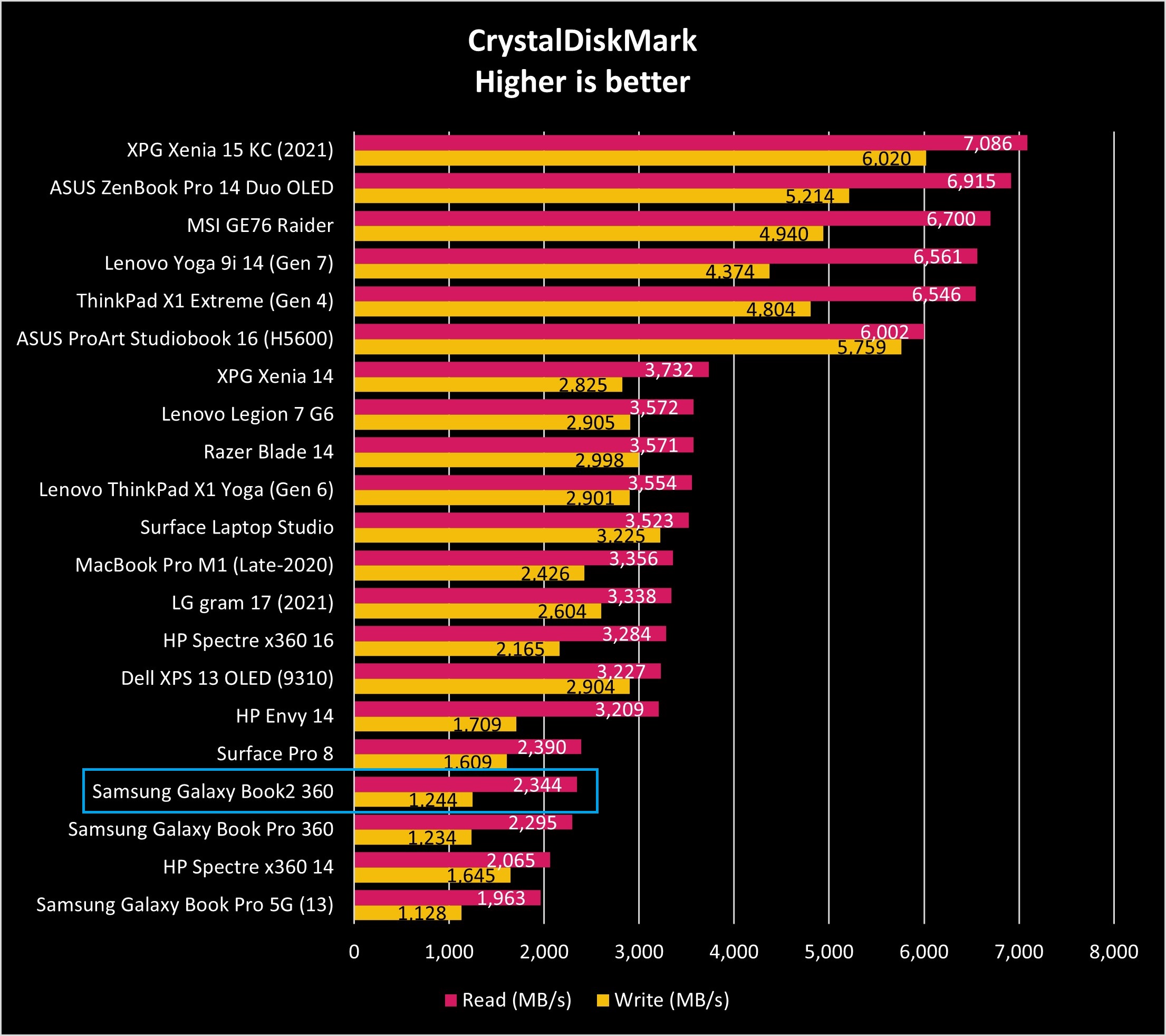
No Fan mode is exactly that and is the first time I have seen it in a Core i7 laptop. The laptop gets warmer than usual (though never hot), and performance is throttled (multi-core performance is halved), but it is a fantastic option for Microsoft Word or when you want to focus on a task and do not want any noise.
Silent mode lets the fan come on, but only slightly. Optimized is the default and enables the system to find a balance between work and comfort. The high-performance mode takes the gloves off and lets the fans roar to the max.
In regular couch surfing usage (web, email, Twitter, Telegram, Slack, watching videos) and in Optimized mode, the Galaxy Book2 Pro 360's fans were occasionally used, but never obnoxious. The laptop also kept temperatures in check, and there were no hot spots.
SSD performance is average (2,295 MB/s and 1,234 MB/s sequential read and write), but nothing groundbreaking either, which is odd considering Samsung makes some of the best (and fastest) SSDs available. The 1TB Samsung PM991a also falls well below that of Galaxy Book Flex with a PM981 SSD. While PCIe 4.0 would have been nice, it tends to run extremely hot making it a bad fit for this chassis.
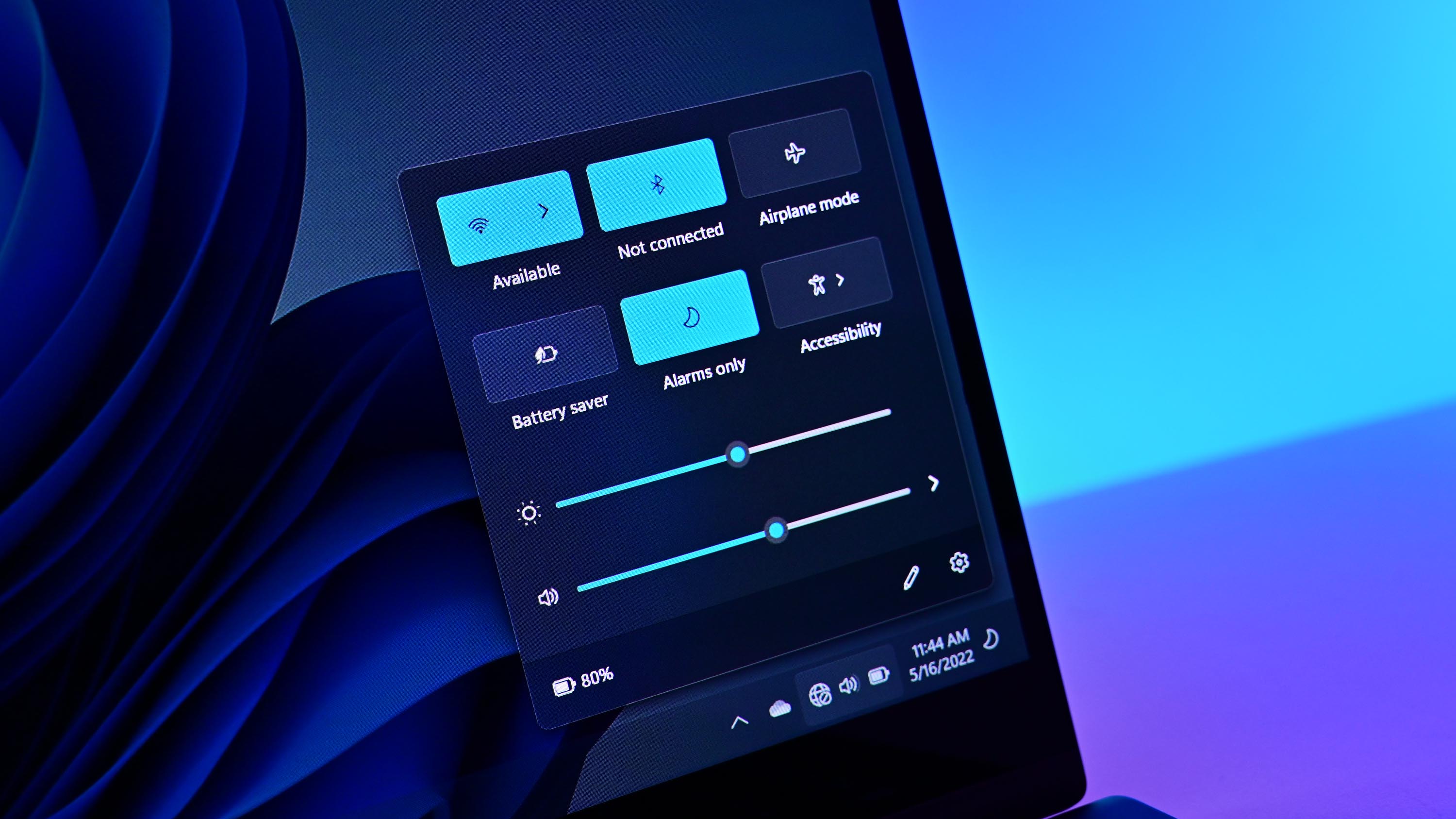
Battery life is quite good thanks to the relatively sizeable 68WHr battery (Surface Laptop 4 only has a 46WHr one). When set to Samsung's 'optimal' performance mode and using the Galaxy Book2 Pro 360 for light to medium work, it averaged around 10 hours 30 minutes on a full charge.
Real-world usage pegs it closer to a solid 8 hours of regular productivity usage (web, email, video) so long as you don't push the display brightness to 100 percent.
Samsung includes a tiny but mighty, Super Fast Charging-enabled 65W AC adapter in the box. It can deliver "8 hours" of battery life in just 30 minutes of charging, which is excellent when in a pinch.
Samsung Galaxy Book2 Pro 360: The competition
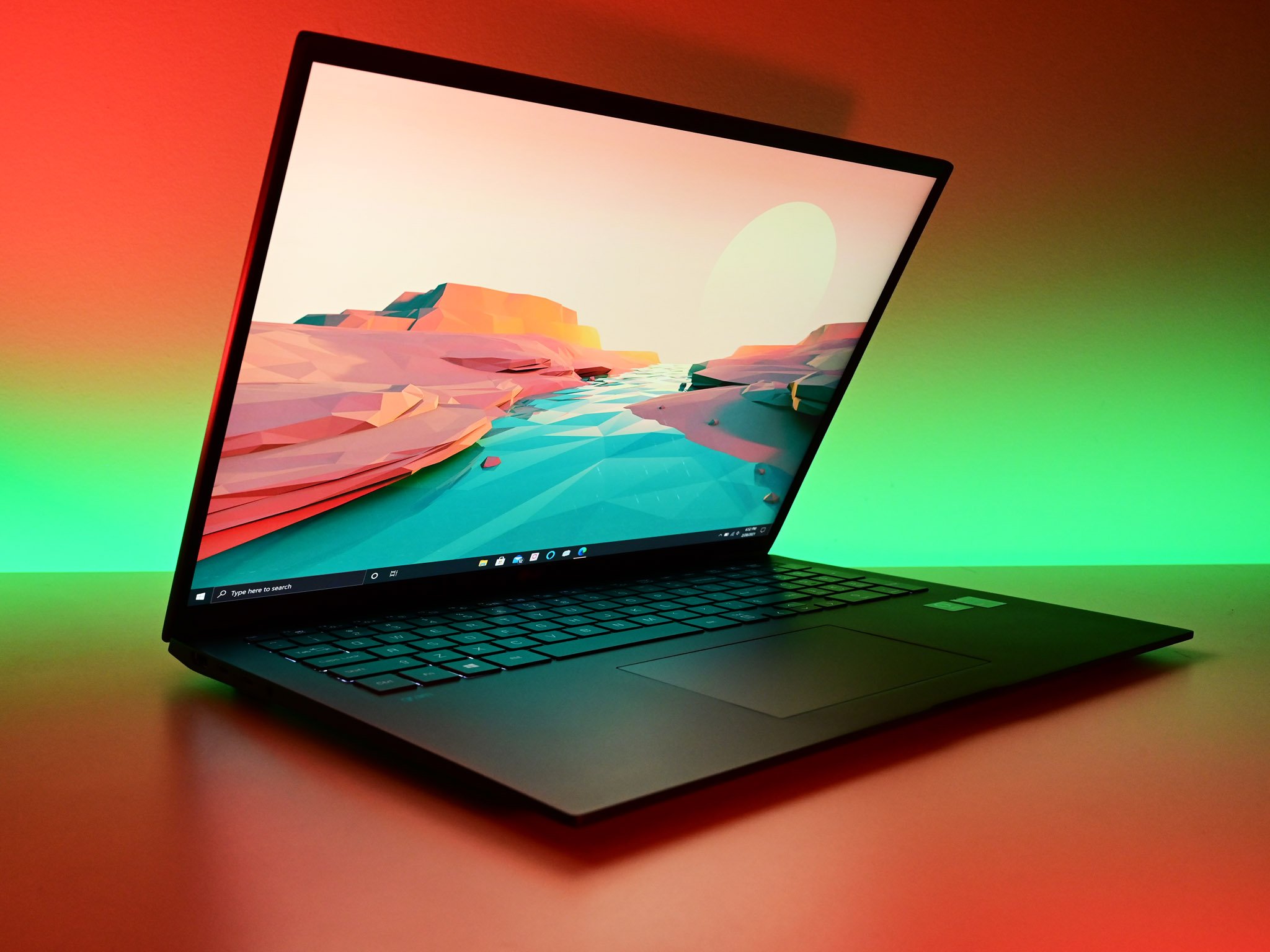
There is not a lot that directly competes with the Galaxy Book2 Pro 360 15-inch as most laptops with that display size feature a 35+ watt CPU and usually a discrete NVIDIA GPU. Fewer are convertibles that support inking, and even fewer of those have a full number pad on the keyboard.
The LG gram series runs in all different sizes, including 13, 14, 15, 16, and the Gram 17-inch. They are all in the same class as the Galaxy Book Pro 360, albeit non-convertible and without inking. The exception is the older (and mostly out of stock) LG gram 14, which is a convertible and weighs only 2.53lbs. The newer (though hard to find) 2021 LG gram 16 16T90P is also a convertible with an i7-1165G7 processor and features a preferable 16:10 display for around $1,600.
Few laptops directly compete with the Galaxy Book Pro 360 15-inch, which is noteworthy.
Lenovo has the excellent Yoga 91 14, which has a higher resolution (but smaller) 14-inch 2.8K OLED (16:10) screen, but it is also a nice convertible with similar specs as Samsung including that P-series processor.
The HP Spectre x360 16 is also a worthy alternative, but it's of a different class with an outstanding 16-inch 3.8K OLED (16:10) display, Intel H-series CPU, and GeForce RTX 3050 GPU. It also weighs 4.45 pounds (2.02kg). Newer models with Intel 12th Gen should be arriving in summer 2022.
The Microsoft Surface Laptop 4 does support inking but is a non-convertible laptop with similar specs. It has better audio and a higher resolution display, and the 15-inch is a similar class as the Galaxy Book Pro2 360 15 but with an AMD Ryzen CPU.
Finally, Samsung has the Galaxy Book Flex with an excellent QLED screen, Qi charger in the trackpad, siloed pen, and a gorgeous design. Samsung also has the Galaxy Book Flex Alpha, Galaxy Book Flex2 Alpha, but only in 13.3-inch models.
See our recommendations for best 15-inch laptops for more ideas.
Should you buy the Samsung Galaxy Book2 Pro 360?
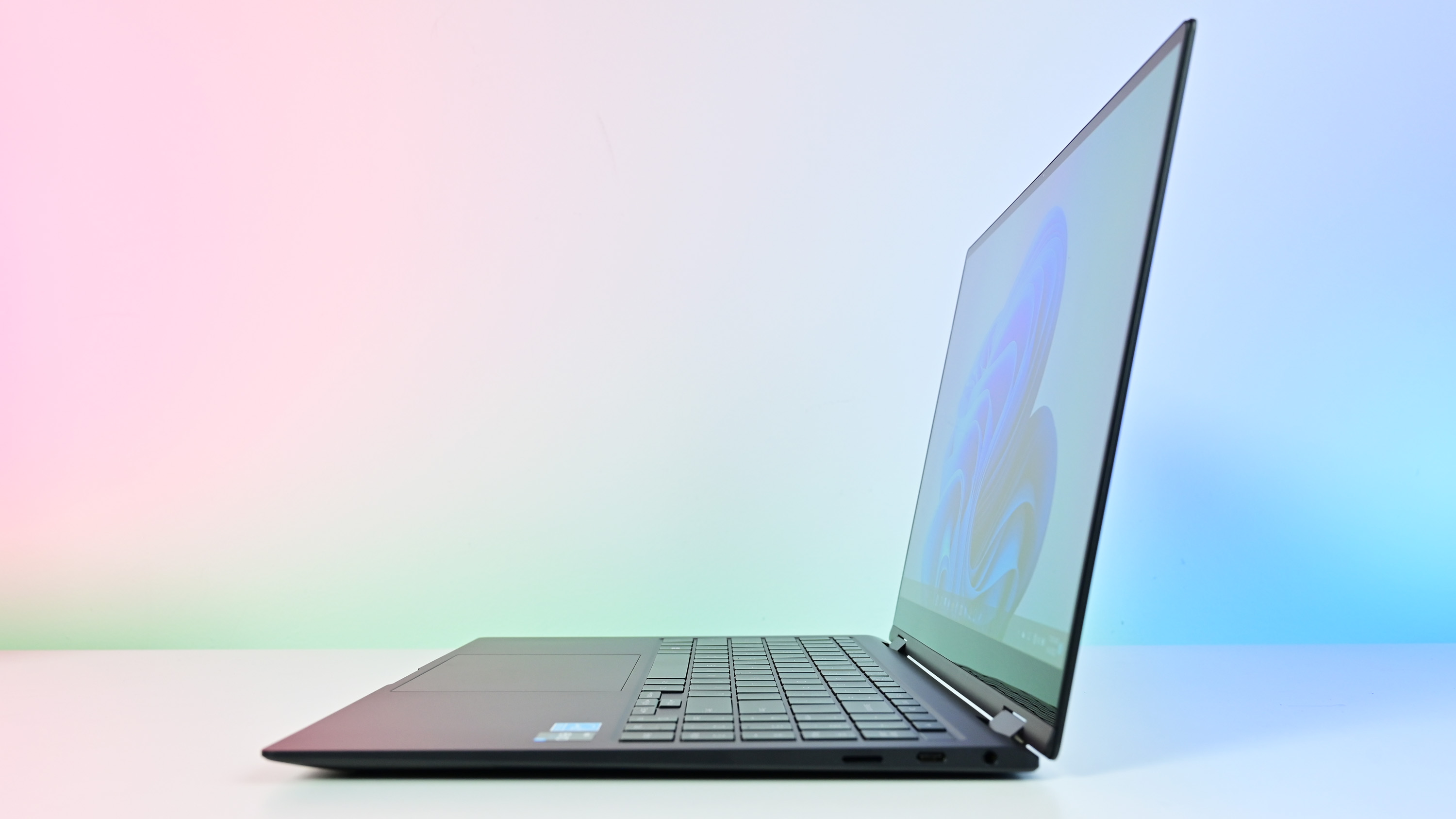
Who it's for
- Those who want an exceptionally light and thin 15-inch Windows laptop
- Owners of a Samsung Galaxy smartphone who need a laptop
- People who love number pads
- Those who need a productivity PC for school, work, or leisure
- People who want a 15-inch convertible laptop that supports inking
Who it isn't for
- People who need a discrete NVIDIA GPU (video editors, gaming)
- People who prefer 16:10 displays
- You want great-sounding audio
Samsung has brought another unique laptop to the increasingly crowded PC space, which is no easy task. The 15-inch Galaxy Book2 Pro 360 has few competitors and fills an exciting gap in the laptop market; namely, super light/thin convertible laptops that also get good battery life and performance.
Samsung has done very well here, but it can do so much more too.
Samsung leans heavily on its AMOLED screen technology, as it should. It's a very color-accurate display that matches LG's LCD screens for color accuracy to no one's surprise. The S Pen is fun to use, and while Samsung has a lot of pre-installed apps, they enhance the experience of this laptop, especially if you already have a Samsung Galaxy smartphone.
Indeed, if you already own a Galaxy smartphone, grabbing this laptop is the closest you can get to Apple's own tightly tied ecosystem. Between the shared photos, ability to sync, Notes, SmartThings, S Pen experience, and usage of a Samsung Account, there is a lot of device interaction. Even Samsung's Buds works better with an auto-connect feature tied to the enhanced Bluetooth pairing ability.
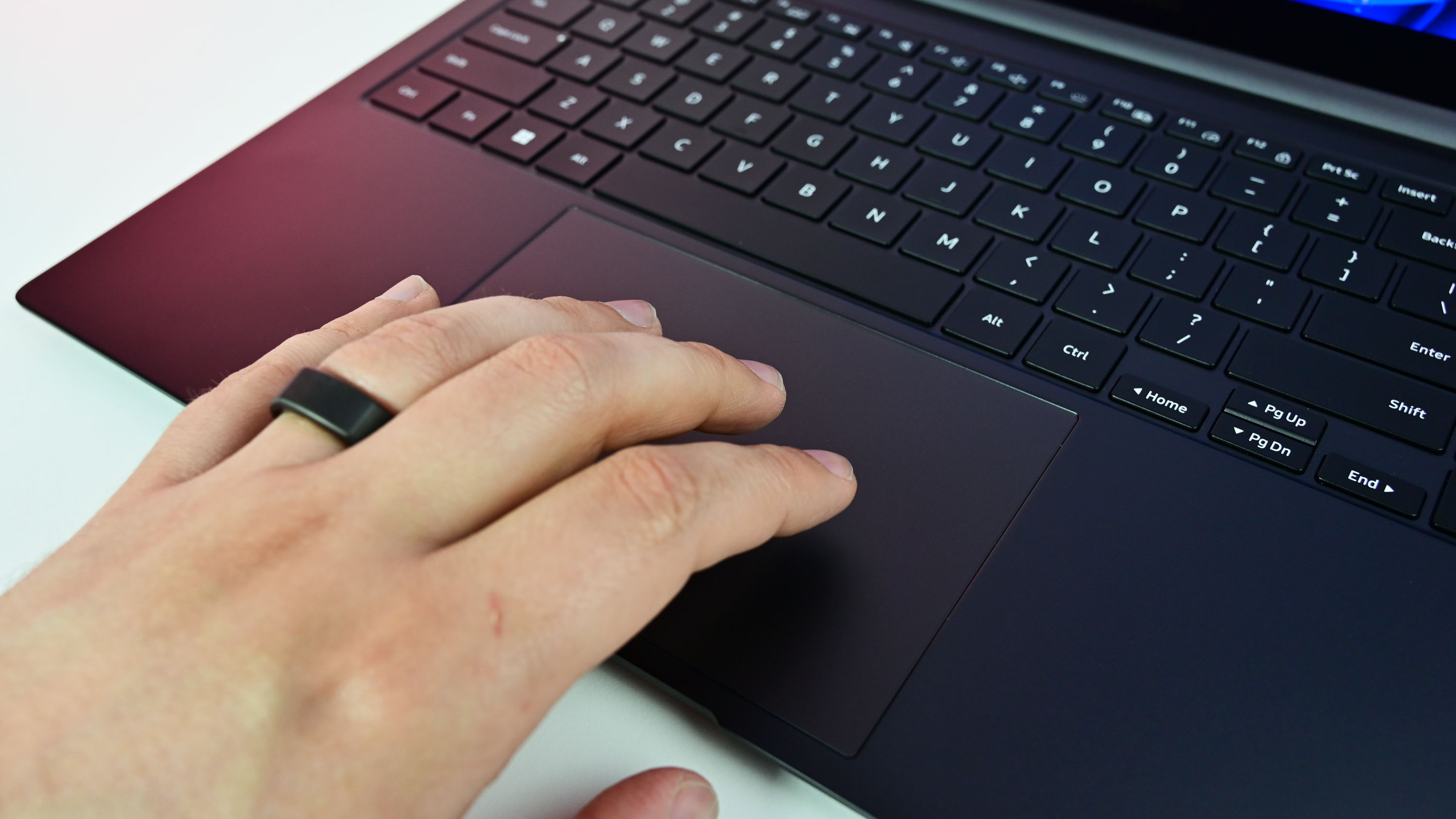
But the Galaxy Book2 Pro 3600 also has some missed opportunities, most notably the display aspect ratio. In 2018, I wrote how the industry needs to shift to 3:2 and since then, Dell, HP, and Lenovo have all slowly pushed towards it and 16:10. The Galaxy Book2 Pro 360 doesn't make sense at 16:9 and 15.6-inches. When used as a tablet for inking, it is very tall and narrow, whereas 3:2 devices match a paper-based notepad experience perfectly.
Additional complaints fall to audio, where bottom-firing speakers are never ideal. And while full HD helps with that battery life, a 1440p "2K" option for 15.6-inches would be a much better experience, especially since many laptops are pushing 4K UHD at this size.
Overall, though, Samsung has created not only a great-looking laptop with some notable features like fanless mode, but it does so at a highly competitive price, making it an easy laptop to recommend. Plus, if you don't need the convertible form factor, you can save $100 and get the standard non-360 design.

Daniel Rubino is the Editor-in-chief of Windows Central. He is also the head reviewer, podcast co-host, and analyst. He has been covering Microsoft since 2007 when this site was called WMExperts (and later Windows Phone Central). His interests include Windows, laptops, next-gen computing, and wearable tech. He has reviewed laptops for over 10 years and is particularly fond of 2-in-1 convertibles, Arm64 processors, new form factors, and thin-and-light PCs. Before all this tech stuff, he worked on a Ph.D. in linguistics, performed polysomnographs in NYC, and was a motion-picture operator for 17 years.
